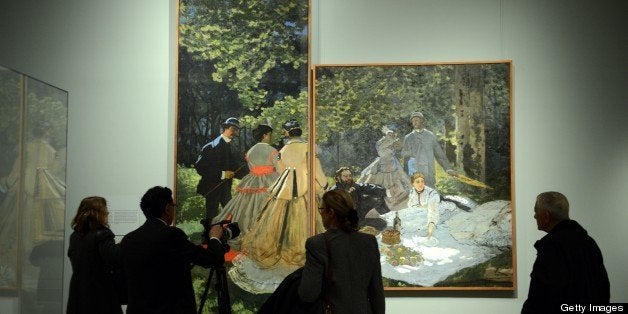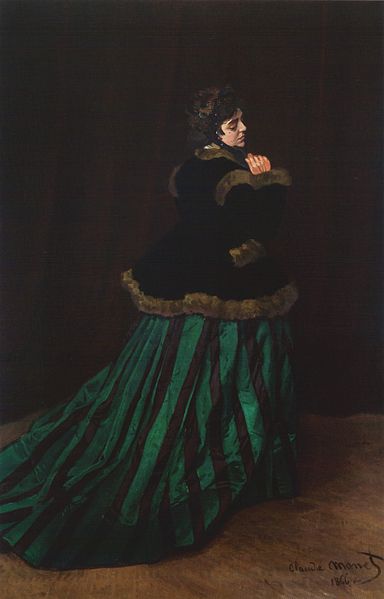
Impressionism, Fashion, and Modernity
The Metropolitan Museum of Art
(Exhibition Closes May 27, 2013)
by Alison Winfield Burns
In great art, there's a relationship between surfaces that are lit and those that are not.
"It's about relationships!" Richard Phillips (a guest instructor from Yale) says to me one afternoon during a figure painting class at Columbia University. He shoves his bare arm into sunlight, showing me the contrast of his skin in bright light and then sharply, in shadow.
Impressionism, Fashion, and Modernity at the Metropolitan Museum of Art displays how master painters (mavericks in their day) created magical gardens -- and gowns -- using relationships between light and dark color.
Nineteenth century writer Emile Zola describes the dresses painted by his friend, the Impressionist Claude Monet, as "fabrics divided in two by shade and sun." At the time, the Paris Salon each year provided the one and only forum that could make or break an artist.
There's an interesting story regarding the Salon of 1866. Claude Monet prepared a series of giant panels (1865 - 66), a work he called "Luncheon on the Grass." Monet used bold, pure colors and juxtaposed solid tints, playing bands of color against one another - scarlet next to brown, a blue sky on fire at the shoulder of a gentleman's otherwise dark, sapphire jacket, or a hot-white parasol stem at contrast to a deep tone in a lady's bodice. Monet considered this to be his finest work and intended it for the Salon of 1866...
Camille and Claude are young lovers. Sexual, romantic lovers. Claude can't pay the studio rent. His Paris landlord confiscates "Luncheon on the Grass." The splendid panels show men and women, dressed as fashionistas, desporting themselves at an outdoor picnic: friends drinking wine, dressed in the finest Parisian couture. But it all molders in the landlord's dank basement, awaiting the rent! Crushed and soiled. Imprisoned. Unfinished.
Claude is desperate to enter work in the Salon. He paints a full-length portrait of Camille; he paints their mutual passion, the struggle to love and to survive. Camille, on a large canvas, dominates The Metropolitan Museum of Art more than any member of an imperial family could ever do, and does it with a glance, "uno squardo," the Romans say, a look of expression.
Like a ripening apricot, love in warm pigment radiates from Camille's gaze, drops down to her lip, and falls to her hand. Oh my god, the glove! Rouge alight. A beeswax of melting coral. Monet's frenzy of impassioned genius. A heavy brown background, a side glance, and the dress! Ebony ribbons against long viridian stripes that buckle you at the knees to behold.
The soul of the painting is the capture of feeling in Camille's face. Her face is minimized because the painting is about her dress - her dress alive in lights and darks because it's worn by a lover for a lover. Camille's loverly glance down the magnificent length of her gown rules The Metropolitan Museum from head to toe by the simple majesty of being in love. You can sense Monet lift with his hand the fur trim of her paletot (jacket) and hold it against his face, catching the delicate scent of Camille's perfume.
While today's exhibit is ostensibly about fashion, it's really about lovers. Claude and Camille are lovers and that is all that you see when you look at this painting, the mightiest here. This is the portrait that "launched" Claude Monet and established Impressionism as a genre.
Paris critics called the portrait of Camille, "The Green Dress." When you see it, the connection that Monet makes between himself, his sweetheart, and each of us who view, will compel you to want to whisper into your own lover's ear and start to unbutton buttons, with reverent awe.
